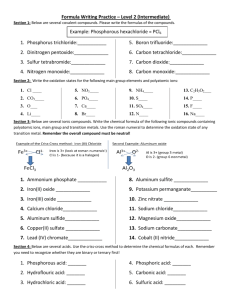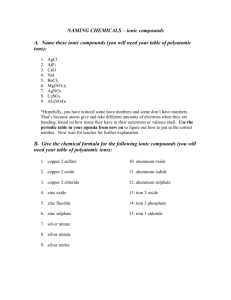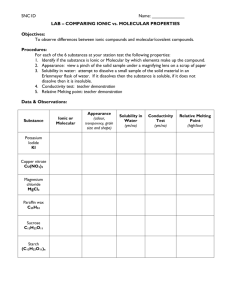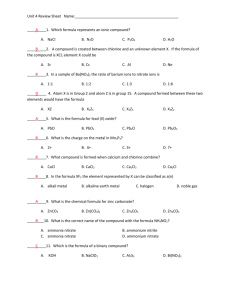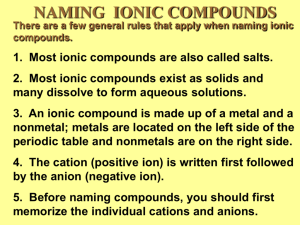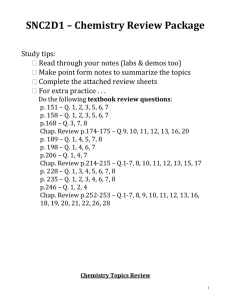Molecular, Ionic, & Acids
advertisement
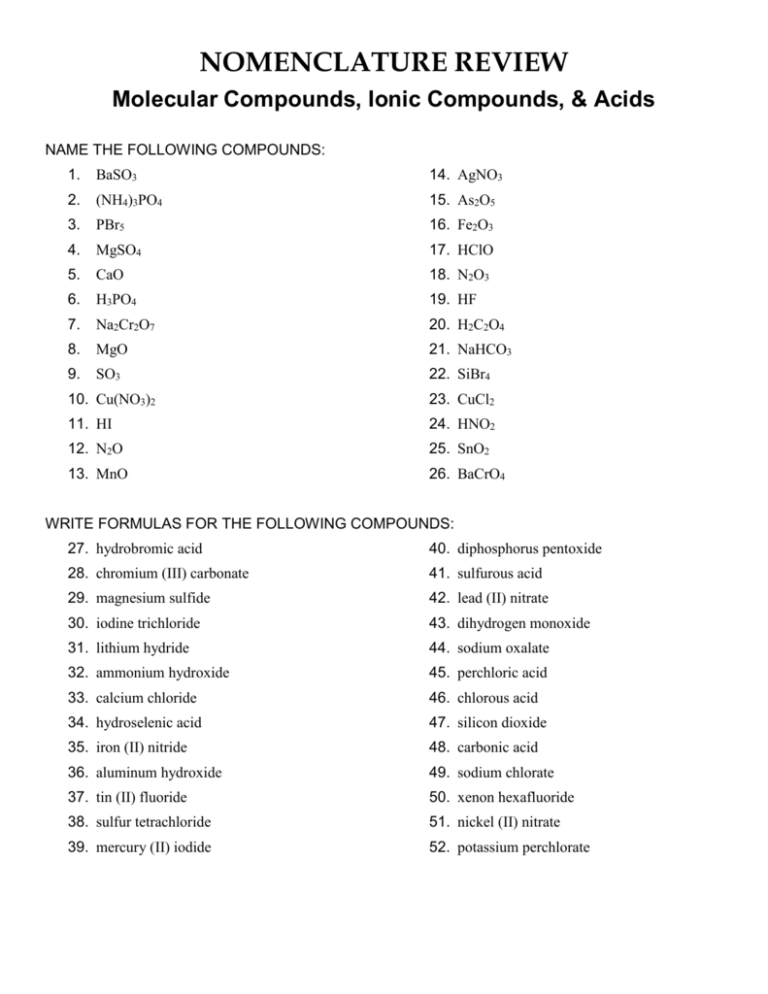
NOMENCLATURE REVIEW Molecular Compounds, Ionic Compounds, & Acids NAME THE FOLLOWING COMPOUNDS: 1. BaSO3 14. AgNO3 2. (NH4)3PO4 15. As2O5 3. PBr5 16. Fe2O3 4. MgSO4 17. HClO 5. CaO 18. N2O3 6. H3PO4 19. HF 7. Na2Cr2O7 20. H2C2O4 8. MgO 21. NaHCO3 9. SO3 22. SiBr4 10. Cu(NO3)2 23. CuCl2 11. HI 24. HNO2 12. N2O 25. SnO2 13. MnO 26. BaCrO4 WRITE FORMULAS FOR THE FOLLOWING COMPOUNDS: 27. hydrobromic acid 40. diphosphorus pentoxide 28. chromium (III) carbonate 41. sulfurous acid 29. magnesium sulfide 42. lead (II) nitrate 30. iodine trichloride 43. dihydrogen monoxide 31. lithium hydride 44. sodium oxalate 32. ammonium hydroxide 45. perchloric acid 33. calcium chloride 46. chlorous acid 34. hydroselenic acid 47. silicon dioxide 35. iron (II) nitride 48. carbonic acid 36. aluminum hydroxide 49. sodium chlorate 37. tin (II) fluoride 50. xenon hexafluoride 38. sulfur tetrachloride 51. nickel (II) nitrate 39. mercury (II) iodide 52. potassium perchlorate NOMENCLATURE REVIEW CHEMISTRY TEST STUDY GUIDE Chemical Bonding Molecular Compounds, Ionic Compounds, & Acids ANSWER KEY 1. 2. 3. 4. 5. barium sulfite ammonium phosphate phosphorus pentabromide magnesium sulfate calcium oxide 6. phosphoric acid 7. sodium dichromate 8. magnesium oxide 9. sulfur trioxide 10. copper(II) nitrate 11. hydroiodic acid 12. dinitrogen monoxide 13. manganese(II) oxide 14. silver nitrate 15. diarsenic pentoxide 16. iron(III) oxide 17. hypochlorous acid 18. dinitrogen trioxide 19. hydrofluoric acid 20. oxalic acid 21. sodium bicarbonate 22. silicon tetrabromide 23. copper(II) chloride 24. nitrous acid 25. tin(IV) oxide 26. barium chromate 27. HBr 28. Cr2(CO3)3 29. MgS 30. ICl3 31. LiH 32. NH4OH 33. CaCl2 34. H2Se 35. Fe3N2 36. Al(OH)3 37. SnF2 38. SCl4 39. HgI2 40. P2O5 41. H2SO3 42. Pb(NO3)2 43. H2O 44. Na2C2O4 45. HClO4 46. HClO2 47. SiO2 48. H2CO3 49. NaClO3 50. XeF6 51. Ni(NO3)2 52. KClO4 Read over your notes, and rework your homework assignments and quizzes (especially those you didn’t do well on). You will be provided with the periodic table reference sheet as well as necessary electronegativity values. You will do AWESOME on this test if you can do the following things. INTRODUCTION TO BONDING Explain what chemical bonds are and why they form. Identify characteristics of covalent, ionic, and metallic bonding. Compare and contrast nonpolar, polar, and ionic bonds. Determine bond type using electronegativity values. Define the following terms: binary/ternary compound monatomic/polyatomic ion MOLECULAR, IONIC, & ACIDS Use Lewis structures to show the formation of molecular and ionic substances from individual atoms. Label partial charges (/) if polar and full charges (+/) if ionic. Name and write formulas for molecular compounds, ionic compounds, and acids. Define the following terms: potential energy dipole bond energy electronegativity lattice energy Explain the following concepts: the relationship between potential energy and stability. the effect of attractive and repulsive forces on stability as two atoms approach each other (PE diagram). the relationship between bond length & bond energy.
